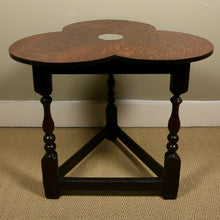The Battle of Trafalgar - H.M.S. Revenge Occasional Table, 1820
Adding product to your cart
62cm (24in) x 67cm (26.5in)
Oak side table with trefoil shaped top inset with an octagonal silver plaque inscribed ‘This table was made from a timber of HMS Revenge, 74 guns upon which battleship Captain John Geary R.N. served as midshipman at the Battle of Trafalgar under Captain H.R Moorsom R.N. It was bequeathed to his brother James Geary who retired from the Royal Navy as Lieutenant in 1821, grandfather of H.A.D Wathen writer of this inscription, 1905 the Centenary of the Battle,’ The whole raised on turned baluster form supports, joined by stretchers.
Provenance:
Captain John Geary, R.N. (1787-1874)
Lieutenant James Geary, R.N. (1795-
Ann Margaret Wathen nee Geary (1821-
H.A.D. Wathen
Read more
The present table was the proud Trafalgar relic of a distinguished naval family, passing through the female line to H Wathen, the son of geologist and politician George Henry Wathen, F.G.S. (1816-1879). The original owner of the table Captain John Geary, R.N., was wounded at Trafalgar on 21 October 1805 as an 18 year-old Midshipman in the newly launched 74-gun third-rate ship-of-the-line H.M.S. Revenge, (Captain Robert Moorsom, R.N.). On sighting the combined fleets of France and Spain, Revenge was situated far to the rear of Collingwood's lee column, but due to her recent construction she was a very fast and was able to overtake two ships in front of her, aiming at the Spanish flagship Pricipe de Asturias, 112-guns, but missing her she became embroiled in a duel with the smaller San Ildefonso, 74-guns, which badly damaged drifted out of action. Revenge next engaged the French 74 Achille, and, dismasting her, left her vulnerable to attack from following ships that sank her. The French Aigle was next. Revenge rammed and damaged her so severely that she too drifted out of action. Finally, reaching the Principe de Asturias, the Revenge was dwarfed by her enormous opponent, and was significantly damaged by the broadsides from the bigger ship, splinters from which badly wounded Moorsom and killed or wounded over 70 others. Asturias was later driven off by the aid of H.M.Ships Dreadnought and Thunderer, who rescued the badly holed and slowly sinking Revenge. By a miracle of seamanship, Revenge was returned to Gibraltar despite the raging storm.
Captain Geary came from an eminent naval family that included Admiral Sir Francis Geary Bt., R.N., Captain Percy, who flourished in the reign of Elizabeth I, and also Admiral Sir Cloudesley Shovel. His three brothers all died Lieutenants in the Navy; as did both of his maternal uncles. Geary himself entered the navy at the age of ten on Christmas Eve 1797 as a First Class Volunteer in H.M.S. Scorpion 16-guns and was soon afterwards present at the capture of a Dutch brig-of-war. In 1804 he was a Midshipman in the East Indies in the 64-gun Trident, flag-ship of Vice-Admiral Peter Rainier, before joining Revenge in the Mediterranean prior to the fleet action off Cape Trafalgar.
Geary was again wounded in July 1806 as Master’s Mate of H.M.S. Monarch, 74, while serving with a detachment of boats at the bloody capture the French corvette Le César, at the entrance of the river Gironde. In September 1806 he was wounded for a third time at the capture of four heavy French frigates off Rochefort, when Monarch compelled La Minerve, 44-guns and 650 men, to surrender. Geary, who was promoted Lieutenant in May 1810 afterwards commanded gun-brig Shade, and schooner Mullet, on the river Elbe and in the Channel. In 1813 he had had his right leg badly fractured while in command of a gun-boat on the Elbe, where he had been trying to bring away a vessel which had been beached. Geary, who was a beneficiary of the Lloyds Patriotic Fund on account of his wounds, also saved the lives of at least three people on different occasions when in fear of drowning.








